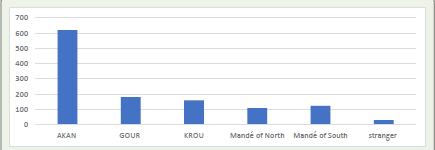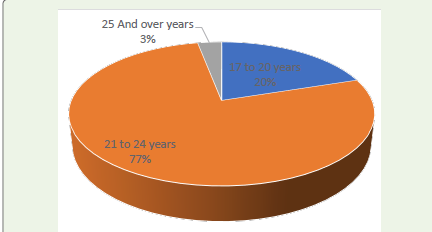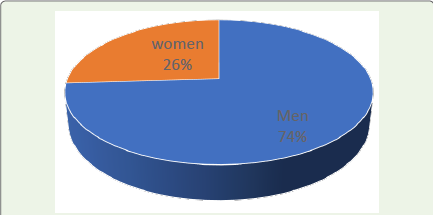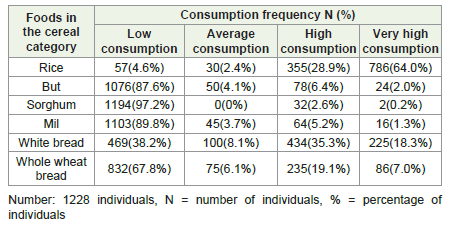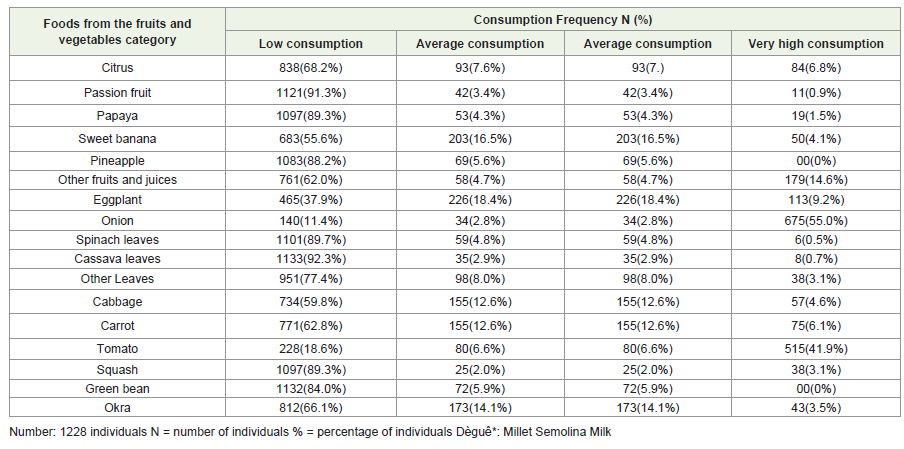Research Article
Food Habits of Students At The Felix Houphouët-Boigny University of Ivory Coast
Anon Franck-Donald N’Guessan 1, ZAHE Kollet Yao Aimé Sylvère 2, Digbé Matogoma epse Blé 3, N’da Mireille-Vanessa Yoboué 4, AHOUA Yapi 5, and AKE-TANO Sassor Odile Purifine 6
1National Institute of Public Health, Abidjan, MSHPCMU Ivory Coast
2Laboratory of Pharmacology and Nutrition, Félix Houphouët BOIGNY University Abidjan, Ivory Coast
3National Institute of Public Health, Abidjan, MSHPCMU Côte d’Ivoire
4UNESCO Chair, Félix Houphouët-Boigny University Abidjan, Ivory Coast
5Félix Houphouët Boigny University Abidjan, Ivory Coast
6Félix Houphouët BOIGNY University Abidjan, Ivory Coast
2Laboratory of Pharmacology and Nutrition, Félix Houphouët BOIGNY University Abidjan, Ivory Coast
3National Institute of Public Health, Abidjan, MSHPCMU Côte d’Ivoire
4UNESCO Chair, Félix Houphouët-Boigny University Abidjan, Ivory Coast
5Félix Houphouët Boigny University Abidjan, Ivory Coast
6Félix Houphouët BOIGNY University Abidjan, Ivory Coast
*Corresponding author:Anon Franck-Donald N’Guessan, National Institute of Public Health, Abidjan, MSHPCMU Ivory Coast, E mail: anonfranc@gmail.com
Article Information:Submission: 11/03/2024; Accepted: 15/04/2024; Published: 19/04/2024
Copyright:© 2024 N’Guessan A F-D, et al. This is an open access article distributed under the Creative Commons Attribution License, which permits unrestricted use, distribution, and reproduction in any medium, provided the original work is properly cited.
Abstract
A prospective cross-sectional study was conducted in order to describe the eating habits of the students of Félix Houphouët University of Côte d’Ivoire. In fact, a food consumption Survey was carried out from October 15, 2016 to February 17, 2017 in a population of 1228 students dominated by male with middleaged
of 22.5-year-old. These investigations revealed a diet dominated by certains types of food, namely rice and white bread in cereals, cassava for tubers (cassava), associated by a high consumption of snack food (peanuts, croquettes, biscuit), sweet foods, soft drinks, flavor enhancers (Maggi cube), against
low consumption of fruits and water. This unbalanced diet, unstructured, little varied and poorly hydrated with a large amount of ultra-processed products andpoor in fiber, is not without consequences for health. In this context, it would be advisable to carry out epidemiological investigations in order to investigate the
specifics impacts that these eating habits might have on the health status of the students. Also nutritional awareness campaigns on all the university campus of the country must be organized in order to improve the food security of the students.
Keywords:Students; Eating habits
Introduction
Eating habits have changed considerably around the world
since the middle of the 20th century. This dietary transition has led
to an increase in the prevalence of preventable chronic diseases of
nutritional origin, both in developed and developing countries WHO/
FAO, (2003). In Côte d’Ivoire, this nutritional change is marked by
a high consumption of red meat, dairy Product (yogurt, cheese),
products with a high glycemic index (sweetened drinks, sweetened
dairy desserts), fatty products (cheese, processed meats and animal
fat), coupled with low fruit consumption, thus exposing populations
to chronic metabolic diseases [1]. This phenomenon is growing and
today concerns all socio-professionals trata (WHO/FAO, 2003)
especially the economically weak among whom students occupy a
considerable place [2]. In 2010, Kouakou’swork, carried out in an
Ivorian school environment, showed that learners had several dietary
gaps and unsuitable eating practices. Six years later, [3] conducted
a nutritional epidemiological study in a population of students
at the Felix Houphouët Boigny University in Abidjan. Shenoted
several health problems such as digestive diseases, respiratory and
neurological disorders. This precarious health state could be linked
to their eating behavior. It is with in this frame work that the present
study is carried out. Its main objective is to evaluate the eating habits
of students at Felix Houphouët Boigny University in Cocody in order
to update the data on the dietary profile and to propose prospects for
appropriate preventive solutions if necessary.
Material and Methods of the Study
Material:
Framework of the Study: The study was carried out at the Félix
Houphouët Boigny University of Cocody located in the Abidjan
District. This university is the largest among the universities of Côte
d’Ivoire. Accor ding to the pre-community diagnostic Survey, students
spend more time on campus, during the school year, generally eating
in University restaurants and surrounding restaurants. The university
has a public restaurant, with subsidized meals, and several other
restaurants offering various dishes (rice, foutou, foufou, attiéke,
placali and tôh) accompanied by sauces such as peanut sauce,
pistachio, palm seeds and vegetables. Sauces usually contain fish or
meat. Around the University, several small businesses also offer food
to students. These include roasted peanuts, bread, pancakes, cakes,
croquettes, with wheat flour and various accompaniments (avocado,
soy, fish, meat, eggs, pasta, potatoes, etc.). These dishes are often
accompanied by drinks (water, soft drinks, industrial sweetened
drinks and traditional sweetened fruit juices, alcoholic drinks).Study population (inclusion, non-inclusion and exclusion criteria):
Any student enrolled in the second year of study in the Chemistry
Biology Geology (CBG) department at Félix Houphouët-Boigny
University who wished to participate in the study was included in
this study. First-year students and those above second year were not
included in the study. All students from other departments were
excluded from this study.Data Collection Tools:
The survey data was collected using a questionnaire designed
for this purpose and validated by a pre-survey of 45 students from
the AGRHYMET Regional Center in NIAMEY (NIGER). It is
structured in two parts. The first part retraced the socio-demographic
characteristics of the study population and the second highlighted the
eating habits (Frequency of food consumption).Methods:
Type of study and sample:This is a prospective cross-sectional
study with a descriptive aim based on a food consumption survey. A
total of 1228 male and female students volunteered to participate in
the study.Frequency of food consumption:Food consumption is
categorized based on the methods used by [3] and [4]. Indeed, food consumption was assessed by the food consumption frequency
method and by the retrospective study of eating behavior, readjusted
over one week.
Consumption of other Food Than Water:
a) Consumption of a food from zero to once per week is
considered lowb) From 2 times a week, consumption is considered average
c) Consumption 3 to 4 times per week is considered strong
d) Consumption of 5 to 8 times per week is considered very strong.
Frequency of water consumption:
a) Water consumption of less than one liter outside of meals per
day is considered low.b) A water consumption of between 1 and 1.5 liters outside of meals per day is considered average.
c) Water consumption of more than 2 liters outside of meals per day is considered very high.
Statistical analysis:
Quantitative and qualitative data were collected. The analysis of
the frequency of consumption by type of food and the general level
of consumption by category of food (cumulative frequency) was done
with SPSS 20 software. The graphs were made with Excel.Ethical aspects:
With regard to ethical considerations, the volunteers were
informed of all stages before the start of the investigation and
were interviewed or examined after free and informed consent.
Confidentiality was assured by assigning an anonymity number to
each survey sheet.Results And Discussion
Socio-Demographic Characteristics:
In terms of sociodemographic criteria, three parameters were
analyzed, namely ethnic group, age and gender.
Regarding the ethnic group, the Akans are the most represented
with a number of 621 peoples, the Krous, the Northern Mandé and the
Gour are respectively 161, 109 and 182 and the foreigners are the least
represented with a workforce of 31 peoples [Figure 1]. Regarding the
age of the respondents, the age of the population was subdivided into
3 groups. Thus, respondents aged 17 to 19 yearsold are 20% and thoseaged 20 to 24 years old and 25 and over are 77% and 3% respectively
[Figure 2]. And in this population, 74% are men compared to 26%
women [Figure 3].
Food Consumption:
a) Consumption of cereal products
There are 92.8% of respondents who have a very high
consumption of cereals. Among cereals, rice (64%) is the
food most consumed by students, i.e. at least 5 days a week,
followed by white bread (18.3%). Whole meal bread comes in
third position among cereals (7%).b) Consumption of tubers and starchy foods
In terms of foods in the tubers and derived products category,
95.1% of students consume them very heavily, that is to say
more than 3 days per week. In this category, attiéké, that
is to say the food made from cassavasemolina, is the most
consumed (45%), followed by foods like plantain (23.5%)
and placali (6.8%). On the other hand, taro (94.2%) and
sweet potato (90.6%) are foods classified as low consumption
during this survey.
c) Consumption of products from the dairy category, sweet
products, and foods containing eggs
Regarding foods in the dairy category, sweet products,
and foods containing eggs, 81.2% consume them at least 5
days a week. Among the foods of high consumption in this
group, croquettes and cakes are the most consumed (11.6%)
followed by biscuits (11.2%). As for low consumption foods,
icecreams (89.6%) and dèguê (85.5%) come first.
d) Consumption of products from the protein-oleaginous
category
The Peanuts are the most consumed oïl seed product;
e) Consumption of products from the red meat and animal fat
category
Concerning animal products, the foods of very high
consumption are beef, sheep, goatmeat (11.2%) and porkmeat
(6.9%)
f) Consumption of products from the redmeat and animal fat
category
In the category of white meats and fish, fishis the food that has
a very high consumption (49.8%) among students, whereas
chicken meat has a low consumption (70.4%).
g) Consumption of products from the red meat and animal fat
category
Regarding stratification according to fruits and vegetables,
the foods heavily consumed by respondents are eggplant
(34%), tomatoes (33%) and onions (30%). Those with low
consumption among this population are passion fruit
(91.3%), cassavaleaves (92.3%), papaya (89.3%) and squash
and zucchini (89. 3%).
h) Level of consumption of products in the alcoholic beverage
category
Beer is the alcoholic drink with the highest consumption
(8.1%), followed by wine (2.8%).
i) Level of consumption of products in the soft drinks and water
category
Regarding water consumption, 27.4% of respondents
have low water consumption compared to 7.6% and 0.5%
respectivelywho have high consumption and very high
water consumption. As for soft drinks, 51.8% have low
consumption, high and very high consumption of soft drinks
is 26.1% and 9.2% respectively. Only 8.1% (7.6% + 0.5)
consume more than 1.5 liters of water.
J) Consumption of products in the spices and derived products
category
The majority of students consume very heavily foods from
the spices and derived products category (56.4%). Chili
peppers are the most consumed spicy product.
k) Consumption of products in the flavor enhancer products
category.
Regarding flavor enhancing products, seasoning cubes are
widely consumed by 55.7% of respondents. Next comes the akpi
(5%). The least consumed flavor enhancer is potash (86.3%).
Discussion
This study, which focuses on the evaluation of the eating habits of
students at the Félix Houphouët Boigny University of Côte d’Ivoire,
indicates that the predominant ethnic group was that of the Akan
Table I:Distribution of respondents according to frequency of consumption of
foods in the cereal category.
Table II:Distribution of respondents according to frequency of consumption of foods in the category of tubers and starchy derived products.
Table III:Distribution of respondents according to the frequency of consumption of foods in the dairy category, sweet products, and foods containing eggs.
Table IV: Distribution of respondents according to frequency of consumption of foods in the protein-oleaginous category.
Table V:Distribution of respondents according to frequency of consumption of foods in the category of redmeat and animal fat or derived products.
Table VI: Distribution of respondents according to frequency of consumption of foods in the white meat and fish category.
with 51% of respondents. This could be explained by the geographical
location of the Félix Houphouët Boigny University of Abidjan which
is more accessible by this ethnic group, especially since the Biosciences
specialty is found in other Universities of the country located in the
North, and in the center. West. These results are comparable to those
of [3]. The study population was young with an average age of 22.5
years and dominated by men. This is explained by the higher level of
education of young boys than that of young girls in Côte d’Ivoire [2].
In terms of eating habits, 92.8% of respondents have a very high
consumption of cereals, rice and white bread are the most consumed.
Regarding foods in the tubers and derived products category, 95.1%
have very high consumption, dominated by cassava (attiéké). These
results are justified by the fact that rice, bread and cassava are very
accessible products in Côte d’Ivoire and constitute the basic diet
of the populations since the phase of dietary diversification in
childhood [5].These results are also comparable to those of Kouamé
Table VII: Distribution of respondents according to frequency of consumption of foods in the fruit and vegetables and derived products category.
Regarding stratification according to fruits and vegetables, the foods heavily consumed by respondents are eggplant (34%), tomatoes (33%) and onions (30%). Those
with low consumption among this population are passion fruit (91.3%), cassava leaves (92.3%), papaya (89.3%) and squash and zucchini (89. 3%).
Table VIII:Distribution of respondents according to the frequency of consumption of foods in the category of alcoholic exciting products.
Table IX:Distribution of respondents according to frequency of consumption of foods in the soft drinks and water category.
Table X:Distribution of respondents according to frequency of consumption of foods in the spices and derived products category.
Table XI:Distribution of respondents according to frequency of consumption of foods in the flavor enhancer product category.
and Enoh (2011) who reported that the eating habits of Ivorians are
mainly oriented towards the consumption of rice and cassava which
contribute the most to the formation of calorific availability per
person and per day. On a national level.
In terms of foods in the dairy category, sweet products, we note
more than 81% of very high consumption, especially cakes and
croquettes. These are widely available snack foods on the University
campus. These results could explain the high level of snacking among
students. Indeed, according to the 2009 survey by the national union of
regional student mutual societies (USEM) in France, 95% of students
snack during the day. The observation is that it is a common practice
in the student environment which is very often part of the student’s
life and can become a compulsion. In general, students spend little
time with their meals and often eat quickly. They often have disjointed
schedules and, most of the time, they seek convenience when it comes
to eating or when class times coincide with lunch times [6].
In terms of protein oil seeds, thereis high consumption (66.5%),
dominated by peanuts. It is also a snacking food. Its high consumption
is also justified by the availability of the product at the national level
[7]. This availability facilitates accessibility to all socio-economic
levels and makes it a widely consumed product in Côte d’Ivoire [8].
In the redmeat category, beef and pork are the most consumed. In
terms of white meat and fish, the diet of the respondents is dominated
by fish which in fact constitutes the source of animal protein most
consumed by the study population [9]. These results are comparable
to those of the WFP which noted that in Côte d’Ivoire, fish is the most
consumed source of animal protein(WFP, 2006).
Fruit and vegetable consumption is dominated by vegetables,
preferably tomatoes and onions. These results are also comparable
to those of the WFP (2006), according to which fruit consumption
is very low compared to that of vegetables in Côte d’Ivoire. The
preference for onion and tomato could be justified by the fact that
attiéké-garba, one of the most popular meals among Ivorians and
particularly students [10],[2] is eaten with tomato, onion and pepper.
More over, pepperis the most consumed spicy food in the
present study. In the non-alcoholic drinks category, many students
prefer sweets and soft drinks instead of water. The majority of
students consume less than one and a halfliters of pure water per
day. Theseresults are comparable to those of the Lucie and André
Chagnon foundation (2016) [11] and those of [12] Benoit, et al
(2003). According to which, the lowlevel of pure water consumption
among young people is a reality linked to the high consumption of
carbonated and energy drinks. The consumption of exciting alcoholic
or non-alcoholicproducts is dominated by coffee and beer, but the
level of alcohol consumption is generally low. These results are
comparable to those of Sylvain Benoit and Marie-Christine Rata [12]
(Benoit et al 2003) who revealed the low consumption of alcohol
among students at the University of Limoge in France. Finally, in the
category of flavor enhancer products, we note a high consumption of
seasoning cubes. These latest results are identical to those published
in 2016 by Amoikon and colleagues and corroborate the conclusions
of Pierre Lepidi’s survey in 2015[13], which estimated that more than
100 million Maggi cubes are sold everyday in Africa.
Conclusion
At the end of this descriptive analysis, we can notice that the
students’ dietis dominated by certain types of foods, namely rice
and white bread for cereals, cassava for tubers (manioc), associated
a high consumption of snack foods (peanuts, croquettes, biscuits),
sweetfoods, soft drinks, flavor enhancing products (Maggi cube),
compared to a low consumption of fruits and pure water. This
unbalanced, unstructured diet, with little variety and little hydration,
with a predominance of ultra-processed products low in fiber, is
not without consequences for health. To this end, it would be wise
to carry out epidemiological investigations to look for the factors
favoring these habits and then to assess the repercussions that these
eating behaviors could have on the state of health of students and
their academic results.

